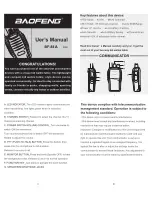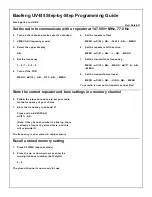
| 3
|
V60 User Guide
and it is your responsibility to determine whether such a license is
required before operating the radio.
•
The frequencies used by this radio are reserved for Maritime use
only and those frequencies must be included on your Radio
Operator’s license.
•
A valid USER MMSI number must be entered into this radio before
DSC functions can be used. You must apply for an MMSI number
which is usually obtained from the same authority that issues the
radio operator’s license. Contact the appropriate licensing authority
in your country. If you’re unsure who to contact, consult your B&G
dealer.
•
A valid ATIS ID number must be entered into this radio before ATIS
functions can be used. An ATIS ID number is issued by Ofcom when
you add one or more pieces of ATIS equipment to your Ship Radio
Licence.
Important information
•
This B&G DSC VHF radio is designed to generate a digital maritime
distress call to facilitate search and rescue. To be effective as a
safety device, this radio must be used only within the geographic
range of a shore-based VHF marine Channel 70 distress and safety
watch system. The geographic range may vary but under normal
conditions is approximately 20 nautical miles.
•
This radio can be configured to operate in your region/country of
operation. The user can select the region/country of operation during
the initial setup of the radio. This is a once-only operation. Should you
require to change the region/country, consult your B&G dealer.
Regulatory Compliance Statements
European Union
Hereby, Navico Holding AS declares that the radio equipment type
V60 and H60 are in compliance with Directive 2014/53/EU (RED).
The full text of the EU declaration of conformity is available at the
following internet address: www.bandg.com
EU RF exposure compliance notice for Fixed Mount VHF
To be protected against all verified adverse effects, the separation
distance of at least 2 m must be maintained between the antenna
of the radio having max. 6 dBi antenna and all persons.




































